Introduction
A visitor today walking along the Keizersgracht in Amsterdam will encounter an elegant canal mansion where since November 2017 the Embassy of the Free Mind has been established, a museum library and a platform for free thinking. This is the home of the Bibliotheca Philosophica Hermetica (BPH), a library dedicated to Hermetic philosophy, founded by Joost R. Ritman in 1957. Two of the main collecting interests of the BPH, alchemy and Rosicrucianism, are embodied in the works of Michael Maier (1568-1622), who was both a staunch advocate of the Rosicrucian Brotherhood and an iatrochemist. The EFM’s collection contains various printed works by or derived from Maier, including a pristine copy of his musical alchemical emblem book, Atalanta fugiens (1618), and two later works based on Atalanta (though published without the music), the Secretioris naturae secretorum scrutinium chymicum (1687, and formerly owned by the Berlin masonic lodge Zu den drei Weltkugeln), and two copies of Chymisches Cabinet (1708). The collection also holds a few manuscript copies of works by Maier, notably a French translation of Atalanta fugiens.[1]
Along with these books, the BPH Collection also has an extraordinary example of applied alchemical art – that is, three 17th-century oak panels painted with emblems from Atalanta fugiens, though the textual elements (the motto and epigram) are left out.[2] [Illus. 1-3]. Two of the panels contain pairs of emblems, respectively: emblems L and I (hereafter Panel 1); and emblems XLII and IX (Panel 2). The third one features three emblems: XXV-XXVI-XXVII (Panel 3). One of these panels, the only one to have been framed (at a later date), though obviously belonging to the same series, was part of the collection of Princess Christina of the Netherlands, which was auctioned in 1996. An interesting added feature in these three panels with emblems from Atalanta fugiens suggests that the patron who commissioned them wished to stress the element of alchemical transformation. In this sense they offer an intriguing yet enigmatic example of contemporary artistic interpretation and reception of one of the most celebrated alchemical emblem books of all times.
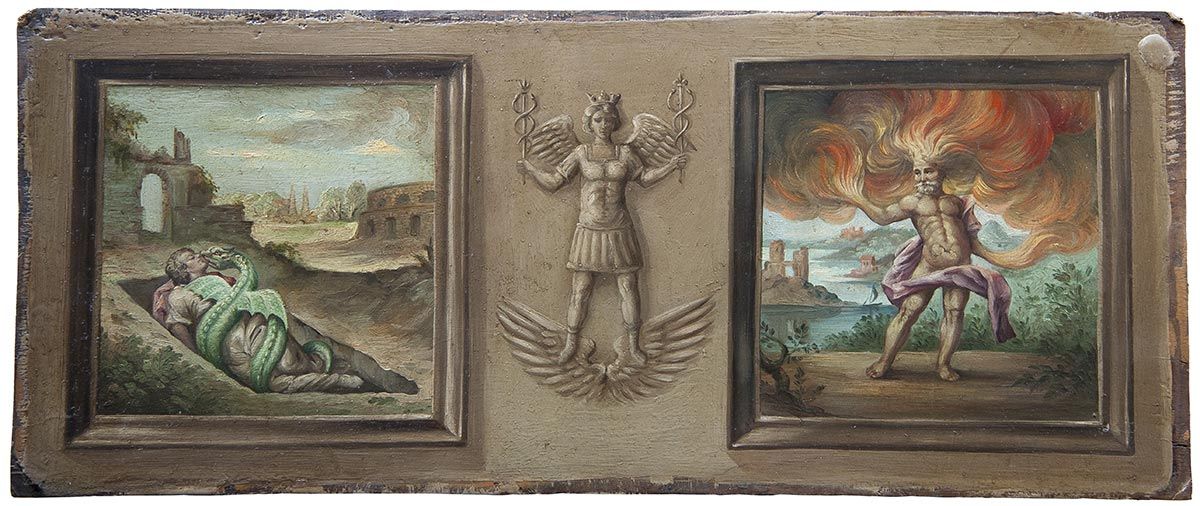
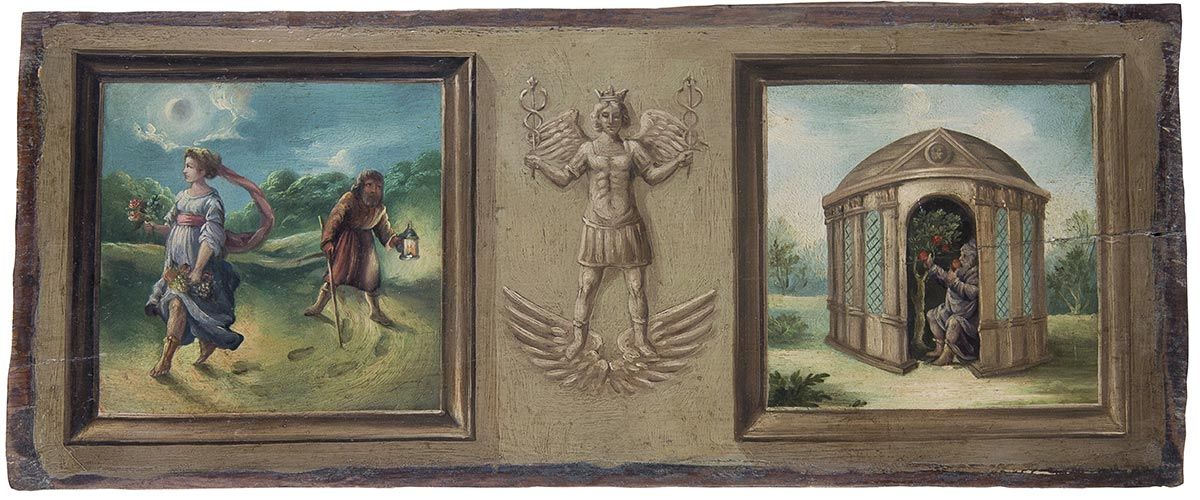

1-3 The three panels: resp. Emblems L-I; XXIV,XXV,XXVI; XLII-IX
Emblems in oak
These three oil-on-oak panel renditions of emblems from Atalanta fugiens were acquired on two separate occasions by Joost Ritman. No records of the acquisition of panels 1 and 2 have been preserved, but Ritman recalls having been informed that they were originally part of an apothecary’s shop. Panel 3 was acquired at auction, described as: “German School, circa 1600. A trompe l’oeil of three emblematic figures enacting mythological episodes. Oil on panel, 24.5 by 46 cm.” [3] The back of Panel 3 features a reduced version in grisaille of Maier’s engraved portrait as it is found in Atalanta fugiens, with the caption ‘Michael Maierus’.[4] [illus. 4] The panels, with on the whole carefully copied emblems from the copper-plate etchings in Atalanta fugiens, have been positively dated to the 17th century.[5] Prior to 1800, the light in 95% of the trompe l’oeil paintings fell from the left, as in these panels. The exceptions were pieces that were specially made for a specific place where the natural light fell differently – usually expensive objects, like altarpieces. The Atalanta panel paintings are relatively to-scale with the images in the book, as they are only about an inch or so larger than their printed counterparts (rather close in size actually, though the addition of the frame around each image in the panels makes them look larger than they really are). It is possible that the panels (perhaps more than these three) were commissioned from a painter to decorate a studiolo, such as, for instance, the emblematic panelling in the Winter Room at Rosenborg Castle in Copenhagen, decorated for the private quarters of Christian IV between 1613-1620. Although the dimensions of the paintings in the Winter Room are larger, it conveys an idea of what such an early 17th-century private chamber would have looked like.
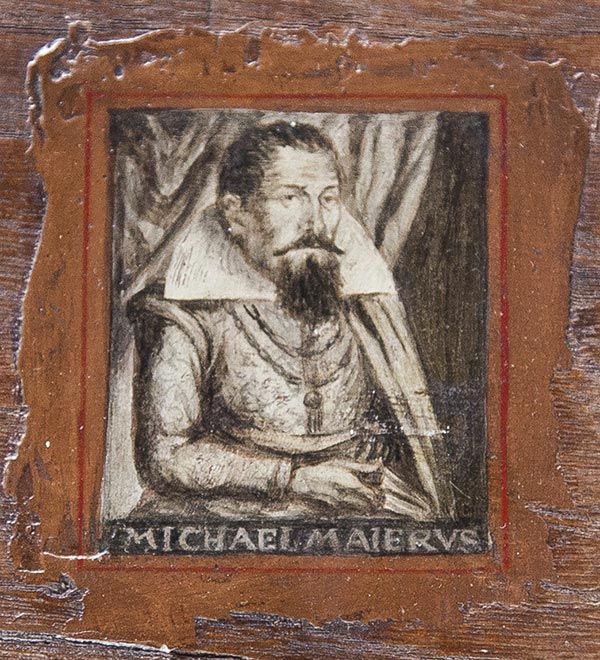
4 Panel 2, verso (details)
The style of painting suggests the Atalanta panels were made in northern Germany,[6] and it seems obvious, given the subject matter and the added features, that they were commissioned by a patron with an interest in the alchemical tradition. If the panels date from the early rather than the late 17th century, the circle of Landgraf Moritz von Hessen-Kassel (1572-1632) might provide likely candidates. ‘Moritz the Learned’ was a renowned patron of the occult arts who attracted many alchemists to his court at Kassel. He founded the Collegium Mauritianum (restyled Collegium Adelphicum Mauritianum) in 1618, employing the Paracelsist Johannes Hartmann as Professor of Iatrochemistry there in 1621.[7] He was also deeply interested in the Rosicrucian Brotherhood; the first Rosicrucian manifesto, FamaFraternitatis, was published in Kassel with his authorization[8] (although Moritz incidentally instigated what might be called the first trial against the Rosicrucian movement, in the town of Marburg, early in 1620).[9] Both in his own circle and elsewhere, Moritz encouraged physicians to prepare iatrochemical medicines, while designs for an alchemical laboratory made by the Landgraf himself in 1604 have also been preserved.[10]
Although the EFM owns “only” three panels, the sequence of the emblems in Panels 1 and 2 suggests that the complete series of emblems from Atalanta fugiens may have been reproduced on wood.[11] If this was the case, it is curious that the sequence probably chosen was to reproduce the ultimate and the first, the penultimate and the second engraving, and so on, rather than copy the order of emblems as they appear in Atalanta fugiens (an assumption based on the three panels in the collection).[12] Even so, the question of why there is a panel with three emblems (XXV-XXVI-XXVII) is a puzzle, as this interrupts the obvious sequence of two emblems per panel and would have resulted in twenty-five panels with two emblems each.[13] The Dutch art historian Heleen de Jong (1930-2010), however, considered emblem XXVI, the middle of the three emblems in Panel 3, to be of central importance.[14] She notes that it is the only emblem to feature biblical references, [15] and the figure of Sapientia[16] who personifies the whole “‘Chymiae, cum praxi’ as Maier says in the discourse”.[17] De Jong also noted that in emblem XXVI, “the connection between hermetic philosophy and the ideals of the Fraternity of the Rosicrucians are shown most explicitly”.[18] Remarkably, the preface to the “wise and understanding reader” in the Fama Fraternitatis begins with an explicit reference to Sapientia or Wisdom:
Wisdom (saith Solomon) is to a man an infinite Treasure, for she is the Breath of the Power of God, and a pure Influence that flowethfrom the Glory of the Almighty; she is the Brightness of Eternal Light, and an undefiled Mirror of the Majesty of God, and an Image of his Goodness; she teacheth us Soberness and Prudence, Righteousness and Strength; she understands the Subtilty of words, and Solution of dark sentences; she foreknoweth Signs and Wonders, and what shall happen in time to come […] Now I do not think that there can be found anyone who would not wish and desire with all his heart to be Partaker of this noble Treasure; but seeing the same Felicity can happen to none, except God himself give Wisdom, and send his holy Spirit from above, we have therefore set forth in print this little Treatise, to wit, Famam & Confessionem, of the Laudable Fraternity of the Rosie Cross, to be read by everyone, because in them is clearly shewn and discovered, what concerning it the World hath to expect.
“Godly wisdom”, as the preface to the Fama Fraternitatis has it, results in “a perfect Medicine of all imperfect Bodies, and to change them into the best Gold, and to cure all Diseases of Men, easing them of all pains and miseries”.[19]
Burin and brush
Although the three Atalanta panels were created by an accomplished painter, there are notable differences between the engravings from the book and their painted reproductions — differences that go beyond the medium that was used, e.g. burin versus brush, as certain details have been omitted, which may have been the result of a deliberate artistic choice. One example is the formal enclosed garden in emblem XXVII, which is engraved with greater precision than the painter who wielded the brush was able or willing to muster. There are also missing background details in emblem XLII, e.g., the farmstead on the hills in the engraving has disappeared in the painting. Similarly in emblem IX, what appears to be a formal garden to the left of the “glass house” (i.e. the domo vitrea referred to in the epigram) has vanished in its painted counterpart,[20] and the town in the distant background on the left in the engraving of emblem XXV has vanished in the painted version (perhaps motivated by the action-packed foreground of Sol and Luna attacking a dragon, which could have caused the painter to decide not to clutter the background with too much detail — but this, too, is speculation). But there are other details missing in the painted panel versions. One striking instance is the bespectacled “traveller” who follows Nature in emblem XLII [Illus. 5], who has lost his glasses in the painted version. This is an important detail, as the glasses in Maier’s commentary refer to Experiment, according to the motto of this emblem: “May Nature, Reason, Experiment and Reading be the guide, staff, spectacles and lamp for him who participates in Chymistry”.
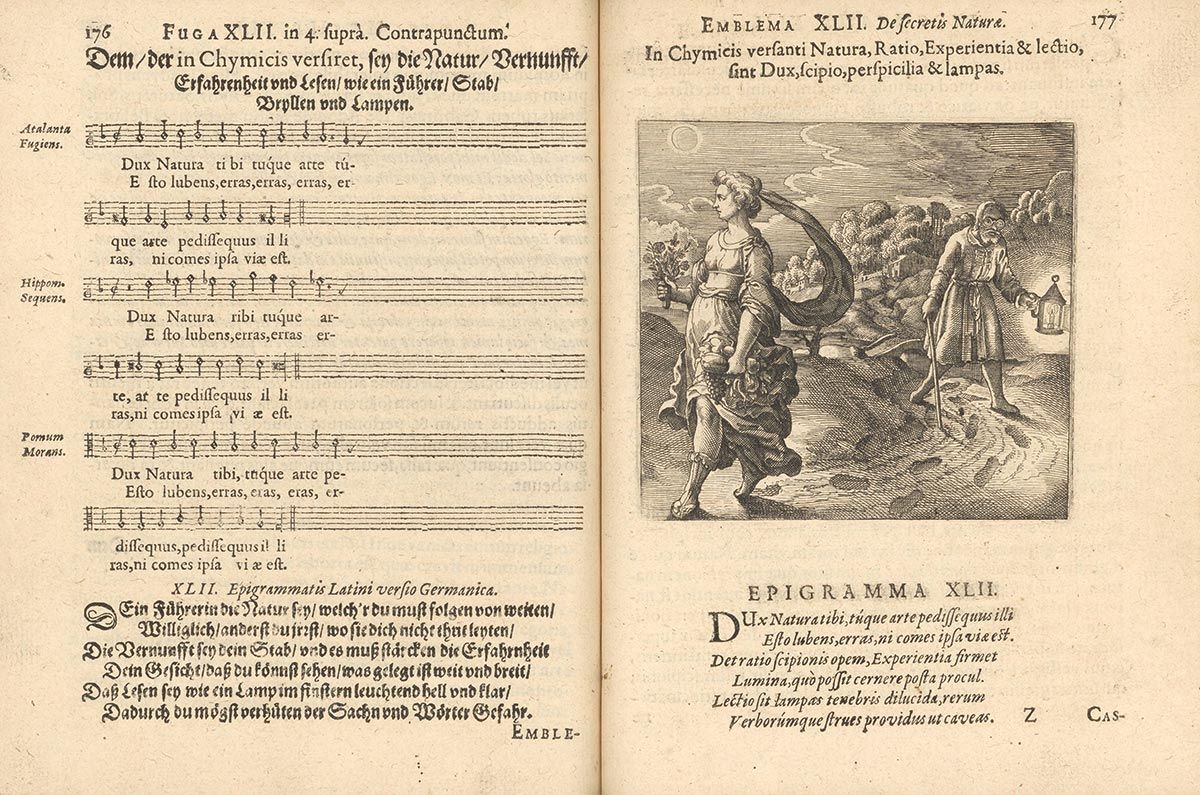
5 -Emblem 42, Atalanta fugiens
The engraved emblem of course closely follows the text; in the painted panel version the reference to alchemical practice is dropped. Whether it was the painter’s oversight (which could easily have been remedied) or a deliberate choice (on whose part?) invites further consideration. Again, as noted in a recent scholarly discussion of emblem XLII, the bespectacled traveller “walks seven steps behind Nature” in the engraving, a figure which is highly significant as there are, for instance, “seven alchemical stages and seven days of creation”.[21] In the painting, however, the traveller walks six steps behind Nature. In the engraving, the seventh footprint of Nature is the one she has just left; the artist working on the painted emblem may have overlooked it, perhaps not having been aware of the symbolical character of the number seven. A detailed iconographic analysis of the two mediums, engraving and painting, might present an avenue of investigation for Maier scholars to pursue.
Shades of black, shades of colour
There are extant copies of Atalanta fugiens, two printed and one manuscript, in which the emblems have been coloured in, although in one case it is almost certainly modern colouring,[22] whereas the painted panels have been determined to be, if not contemporary with the printed edition, at least dating from the 17th century. A comparison between the three different mediums, print, manuscript and painting, is not really very conclusive. The skies are blue, the grass is green, as are the serpents in all three mediums — as we might expect these snakes to be. Nobody can deny, however, that the first emblem of the painted panels, with its fiery Boreas, has a dramatic quality unmatched by its coloured paper equivalents, printed or manuscript. Boreas, the god of the north wind, was traditionally depicted as a temperamental old man with a wild beard and hair. In the engraved emblem as in the painted version, Boreas has a well-kempt beard, but the hair is wild indeed – and dramatically heightened with fiery red in the painted panel. Red would also be a highly appropriate colour to use, as the Philosophers’ Stone in Boreas’ belly is associated with the colour red. Placed side by side with the engraved original, it is not difficult to see how colour impacts our reception of the emblems.
Hermes in grey
In all three oak panels we see a winged Hermes standing on a pair of wings and carrying a caduceus in either hand; he is placed in between the pairs of emblems from Atalanta fugiens in Panels 1 and 2 and above the three emblems in Panel 3. This addition of a grisaille figure of Hermes is a remarkable feature, without which the panels would be an accomplished but fairly straightforward reproduction of the emblems in Atalanta fugiens. The patron who commissioned these panels obviously wished to stress the process of alchemical transformation by having the figure of Hermes (or Mercury), the “active ingredient of the tincture that caused transmutation”,[23] preside over the panels. The interesting thing in this respect is that Maier has generally been regarded in the literature as anything but a strident Paracelsist, more as someone who was given to a “friendly coexistence” between Galenic and Paracelsian medicine.[24] The recent discovery of nine letters written by Maier has prompted scholars to propose a substantial revision of “our understanding of the position of Maier’s medical practise vis-à-vis Paracelsianism and the harnessing of supernatural agencies”.[25] In terms of the reception of the emblems, however, the presence of the grisaille Hermes in these three panels seems to point to a decided Paracelsist outlook on the part of the patron who presumably commissioned the artwork.
The grisaille figures appear to be drawn from two sources (Hermes is featured in all three panels, ‘Sol’ and ‘Luna’ in one)– with the figure of Hermes being a combination of these two, as will be explained below.[26] [illus. 6-8] This grisaille image of Hermes would seem to be based on two separate though related engravings, which both illustrate the alchemical stage of separation. The first engraving draws on The Second Key in Basilius Valentinus’ Practica cum duodecim clavibus (1618), while the second one is based on Johann Daniel Mylius’ Philosophia reformata (1622). In Practica cum duodecim clavibus, Hermes is placed between two “combatants”, or as Basilius Valentinusexplains:
… what matter you ought to take to the Kings Balneum,[27] whereby the Key is destroyed, and its external form broken, and its undefiled Soul may come forth, to this purpose will serve the Dragon and the Eagle, which is Niter and Sal armonick, both which after their union are made into a Aquafort.[28]
Basilius Valentinus’ seminal work was included in Tripus aureus, a collection of three alchemical texts translated by Michael Maier, engraved by Matthäus Merian and published by Lucas Jennis in Frankfurt in 1618.[29] Mylius’ Philosophia reformata, which was also published by Lucas Jennis,[30] appeared four years later; here we see Hermes in the seventh emblem, where the word “Separatio” is also engraved in the emblem.[31] The stage of separation is necessary to accomplish “the miracle of the one”, or in Mylius’ explanation of this emblem:
Prepare therefore while preparing and cleansing, separate by purifying, by collecting the mastery, and divide the stone into two principal parts, namely the upper part that rises and is spiritual and airy, and a lower part that is terrestrial […] whose division is necessary to perform the miracle of one nature that is, the generation of the stone of the philosophers.[32]
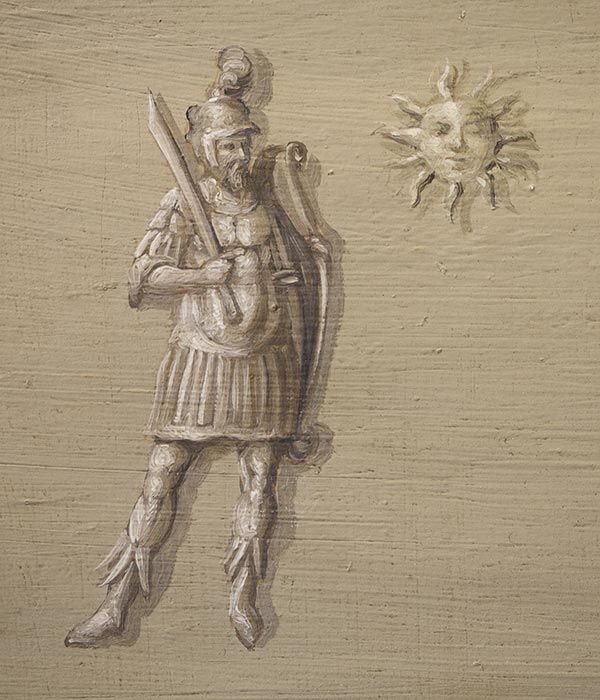
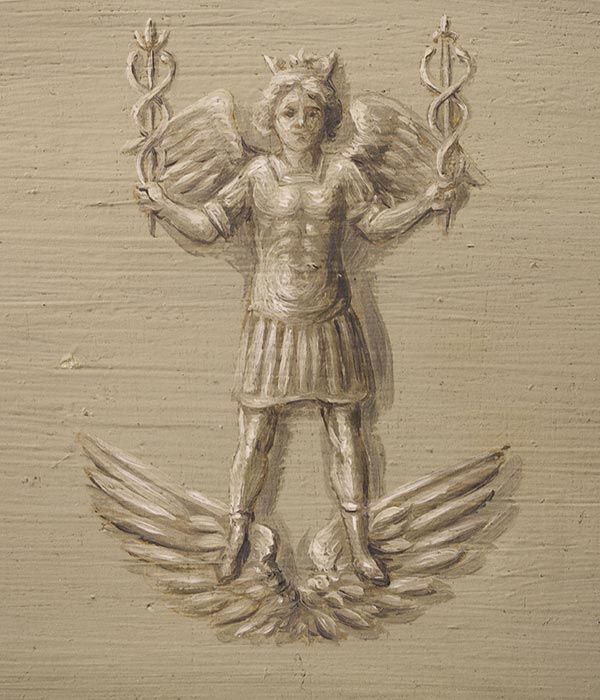

6-8 Details showing the grisaille Hermes and Sol|Luna (panel 2)
The posture of the winged Hermes with his arms raised is clearly derived from the engraving in Basilius Valentinus, while his armour and the position of his feet on the wings is obviously based on the engraving in Mylius.[33] The source for ‘Sol’ and ‘Luna’, the male and female figure flanking Hermes in Panel 3, is likewise the seventh emblem in Mylius’ Philosophia reformata. The two works by Mylius and BasiliusValentinus respectively that inspired the grisaille figures in the panels were included, finally, in Daniel Stolcius’ Viridarium chymicum, again published by Lucas Jennis, in 1624 (second edition 1688), which may mean that this work was the ultimate source for the figures.[34] [Illus. 9-10] The French editor of Stolcius’ emblematic masterpiece considered it a work that was specifically targeted at iatrochemists.[35] It was Jennis who requested Stolcius to provide epigrams for copperplates that were already in his possession, such as the engravings in the editions of Basilius Valentinus and Mylius.
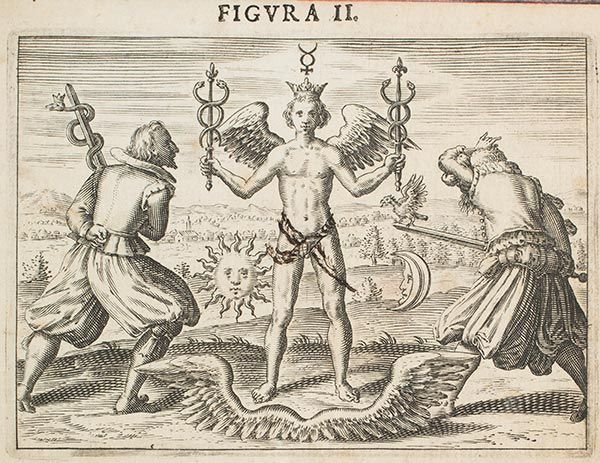
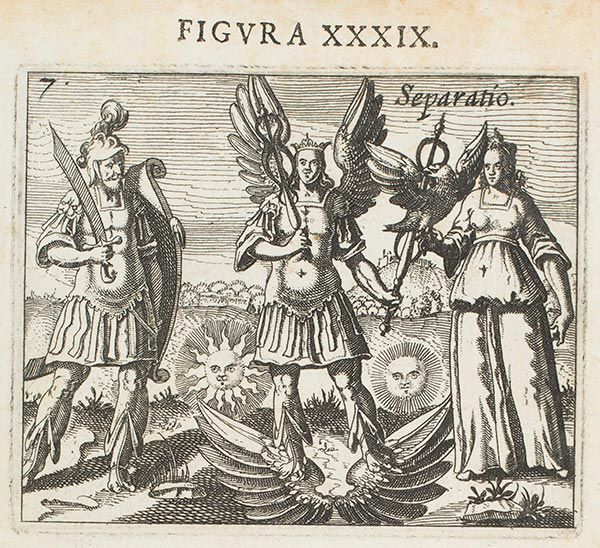
9 Basilius Valentinus, Second Key, in Viridarium 10 Mylius, emblem no. 7, in Viridarium
There is one more link between Maier and Mylius, as the iconography of Mylius’ Philosophia reformata (the engravings were made by Balthasar Schwan, who signed his name on the title page: ‘Baltzer Schwan fecit’) draws on the emblems in Atalanta fugiens. The title page [illus. 11] features ten circular emblems, six of which have precedents in Maier’s celebrated emblem book.[36]
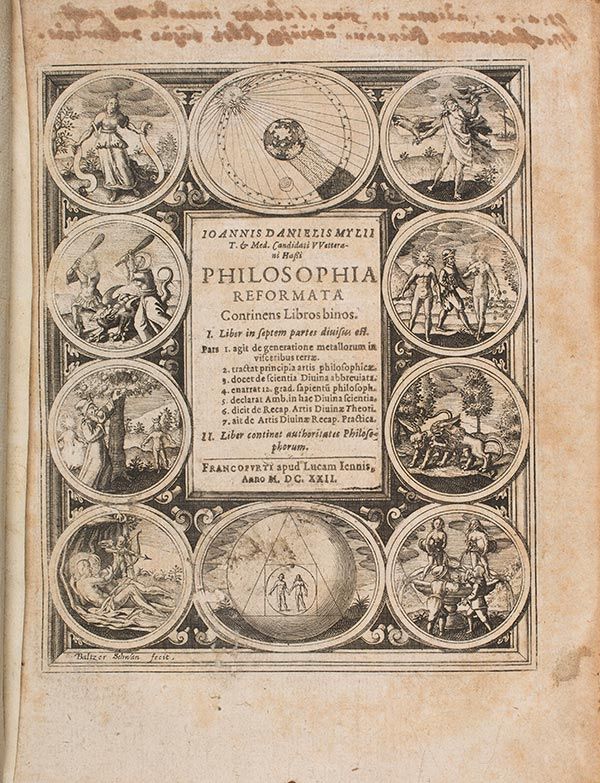
11 Mylius’ Philosophia reformata, title page
As stated previously, Gregor Weber regarded it highly likely that the
panels were originally commissioned by a noble or wealthy patron. He
also suggested their origin might lie in northern Germany, based on the
style of painting. It is interesting to note in this respect
that Myliusand Stolcius became personally acquainted at the court
of Landgraf Moritz von Hessen-Kassel; Mylius provided an entry
for Stolcius’ album amicorum between November 1622 and March 1623,
when Stolcius stayed at the court of Moritz the Learned. By signing as
‘verae fideiRosaeque comes’ (Friend of the true faith and the
rose), Mylius proclaimed his allegiance to the Rosicrucian cause.[37] As
for the author of Atalanta fugiens, Moritz had briefly employed
Maier as a correspondent and informant on alchemical arcana in
1618-1619.[38] It
is probably a curious coincidence that places the three authors so
closely connected to these panels at the court of Moritz von
Hessen-Kassel (two of them simultaneously), but it may provide an
incentive for further research on the part of Maier scholars or
historians of alchemy into the ultimate origins of these three
extraordinary panels.
Cis van Heertum and José Bouman
[1] French translation of Atalanta fugiens entitled Emblèmes (though without the actual emblems and fugues, so probably based on the Scrutinium chymicum), shelfmark BPH 517 — this manuscript has been digitized and is available via the EFM’s website.
[2] Physical dimensions of the three panels: panel 1: 16.5 x 39.5 cm, the emblems (including the trompe l’oeil frames) 13.5 x 13.5 cm; panel 2: 16.5 x 40.5 cm, the emblems (including the trompe l’oeil frames) 13 x 13.5 cm; panel 3 (without the frame): 24.5 x 46 cm, the emblems (including the trompe l’oeil frames) 12 x 12 cm.
[3] The Collection of HRH Princess Christina of the Netherlands, Sotheby’s Amsterdam 19 and 20 November 1996, lot no. 70, p. 39, with illustration.
[4] The inscription KW 829 on the back of the panel led Gregor Weber to think the panel had previously been auctioned by Christie’s. The panel was indeed auctioned by Christie’s as lot 588 on 4 July 1991, and described as ‘German school, 1617’.
[5] We are grateful to Gregor Weber (Head of the Department of Fine and Applied Arts, Rijksmuseum) for examining the panels and offering his expert opinion. Weber is ‘99% certain’ that the oak panels are 17th-century, while technical analysis could yield more information.
[6] Weber posits Denmark as another possibility, though he rules out southern Germany, which had a landscape tradition that was altogether different from the style used in these panels (e.g. their use of colours). There is a real possibility that the panels were produced in Kassel or surroundings as the style of painting is consistent with paintings produced in that area.
[7] Hartmann was married to the sister of the iatrochemist Johann Daniel Mylius and had established a laboratorium chymicum publicum in Marburg, where he had previously been appointed to teach medicine and iatrochemistry by Landgraf Moritz in 1609.
[8] Carlos Gilly, Cimelia Rhodostaurotica. Die Rosenkreuzer im Spiegel der zwischen 1610 und 1660 entstandenen Handschriften und Drucke, Amsterdam 1995, p. 70.
[9] Gilly, ‘Die Rosenkreuzer als europäisches Phänomen im 17. Jahrhundert und die verschlungenen Pfade der Forschung’, in Rosenkreuz als europäisches Phänomen im 17. Jahrhundert, eds Carlos Gilly & Friedrich Niewöhner, Amsterdam 2002, p. 23
[10] Bruce T. Moran, ‘Moritz von Hessen und die Alchemie’, in Moritz der Gelehrte. Ein Renaissancefürst in Europa, eds Heiner Borggrefe, Vera Lüpkes, Hans Ottomeyer, Eurasburg 1997, pp. 357-360; Moran, The alchemical world of the German court. Occult philosophy and chemical medicine in the circle of Moritz of Hessen (1572-1632), Stuttgart 1991, p. 116. The inventory of Moritz’s household effects is kept in the Hessisches Staatsarchiv Marburg, shelfmark 4b 164.
[11] Based on the two oak panels with emblems L-I and XLII-IX in the BPH Collection, it is conceivable that there were more panels featuring emblems XLIX-II, XLVIII-III &c.
[12] Peter Forshaw suggested this might imply an intended circularity or circulation of the images and processes represented in Maier’s emblem book. According to Heleen de Jong, there is no strict sequential order to the emblems in Atalanta fugiens as they ‘do not intend to render a fixed succession of various alchemical processes, beginning with looking for the primary matter, and ending with finding the Philosophers’ Stone’, H.M.E. de Jong, Michael Maier’s Atalanta fugiens, Sources of an alchemical book of emblems in 1969 (reprinted by Nicolas-Hays in 2002), p. 333.
[13] There is the possibility, still assuming that all emblems were reproduced, that there were two panels with three emblems, i.e. not only XXV-XXVI-XXVII but also XXVIII-XXIII-XXIV, though in that case the question is why the choice was not made to feature emblems XXIII-XXIV-XXV and XXVI-XXVII-XXVIII respectively.
[14] By highlighting the Atalanta fugiens emblems on wood panels in the BPH Collection, we also wish to pay tribute to Heleen de Jong, who pioneered art historical research into Atalanta fugiens with her 1964 dissertation on the emblems and their alchemical sources. After studying art history at the University of Utrecht, de Jong furthered her work on Maier’s emblems with a fellowship from the Alexander von Humboldt Foundation. She was also a close associate of the BPH Collection and curated the 1988 exhibition, Les symboles spirituels de l’alchimie (Festival International de l’Esotérisme in Carcassonne, France), which was one of the first events to put the BPH Collection in the international spotlight.
[15] Michael Maier, Atalanta fugiens: ’Thus Solomon, in his book Sapientia, speaks about wisdom as follows: ‘Those who are akin to it are immortal and in her friendship there is pure delight’’, de Jong (see note 13), p. 196.
[16] The mottos in the banderoles held by Sapientia read: ‘Longitudo dierum et Sanitas’ (Length of days and health) and ‘Gloria ac divitiae infinitae’ (Honour and infinite riches), seeProverbs 3:16: ‘Long life are in her right hand, in her left hand are riches and honour.’
[17] See also Donna Bilak, ‘Chasing Atalanta’ in this volume for an in-depth analysis of Sapientia, and Bilak, https://atalantachf.omeka.net/exhibits/show/about/sectionfour/xxvi (2014)
[18] De Jong (see note 13), pp. 198-199 and pp. 334-335.
[19] The fame and confession of Fraternity R:C:, transl. Thomas Vaughan, London, printed for Giles Calvert, 1652, A4v-A5r and A8r.
[20] For a chemical analysis and textual interpretation of this emblem IX see Lawrence M. Principe, ‘Apparatus and Reproducibility in Alchemy’, pp. 55-74 in Instruments and Experimentation in the History of Chemistry, eds. Frederic L. Holmes and Trevor Levere, Cambridge, MA, 2000.
[21] D. Bilak, Atalanta fugiens lecture notes from Wadsworth Atheneum Museum of Fine Art (November 2017).
[22] We are grateful to Donna Bilak for drawing our attention to the following coloured versions: the 1618 Atalanta fugiens copy in the Donald F. and Mildred Topp Othmer Library of Chemical History, Chemical Heritage Foundation (the first 11 emblems are hand-coloured, but Bilak thinks it is probably 20th-century colouring), the Bibliothèque Nationale de France (FRBNF30860339), and the coloured manuscript at the Getty Research Institute which is probably based on Scrutinium chymicum as the fugues are missing.
[23] Pamela H. Smith, The Business of Alchemy. Science and Culture in the Holy Roman Empire. Princeton (NJ), 1994, p. 219.
[24] See e.g. Volkhard Wels, ‘Poetischer Hermetismus. Michael Maiers Atalanta fugiens (1617/18)’, in Konzepte des Hermetismus in der Literatur der Frühen Neuzeit, eds. Peter-André Alt & Volkhard Wels, Göttingen 2010, pp. 160-162.
[25] Nils Lenke, Nicolas Roudet, Hereward Tilton, ‘Michael Maier: Nine newly discovered letters’, in Ambix, vol 61-1 (2014), p. 2.
[26] An ultimate source uniting these features of Hermes has yet to be identified.
[27] Balneum regis or the King’s Bath was a metaphor for antimony ore, the corrosive agent which could purify gold, see John Read, Prelude to chemistry. An outline of alchemy, Cambridge (Mass.), 1966 (first ed. London 1936), p. 201.
[28] Basilius Valentinus his last will and testament, London, printed by W.B. for T. Davis 1658, p. 121. See also Lawrence M. Principe, The secrets of alchemy, Chicago 2013, p. 161: ’The twelve keys exemplifies one major route to the stone, called the ‘wet way’ (via humida) because it employs watery solvents — in this case, the acidic water of the fighters.’
[29] Later illustrated 17th-century editions of Basilius Valentinus’ Twelve Keys include Von dem grossen stein der uralten Weisen, Strasbourg 1626, 1651 and the French translation Les douze clefs de philosophie, Paris 1624.
[30] Johann Daniel Mylius, Philosophia reformata, Frankfurt: Lucas Jennis, 1622. The engravings for Mylius were cut by Balthasar Schwan, an engraver often employed by Jennis, see M.E. Warlick, ‘The domestic alchemist’, in Emblems and Alchemy, eds Allison Adams and J. Stanton Linden, Glasgow 1998, pp. 39-40. For Mylius and the Rosarium philosophorum tradition see also Joachim Telle, Sol und Luna. Literar- und alchemiegeschichtliche Studien zu einem altdeutschen Bildgedicht, Stuttgart 1980, pp. 64-66.
[31] J. Van Lennep, Alchemie. Bijdrage tot de geschiedenis van de alchemistische kunst, Brussels 1984, p. 205 (in translation): ’The illustration of the separation corresponds with the second Key of Basilius. But here, too, there is a difference: the two combatants threatening the mercury, have been replaced by a pair: Mars with a sword, and a woman with a bird on her hand. As the separation must take place when the matter is black, we believe this could be a raven, the more so because alchemists interpreted the ‘raven’s head’ to be the putrified matter obtained as a result of this separation. The sword of Mars would then serve to bring about this decapitation or separation.’; see also John Read, Prelude to chemistry (note 27), pp. 262-263: ‘The third stage, which is symbolized in a manner suggestive of the Second Key of Basilius, is called our separation, which is the purifying of watery vapour or liquorous matter from its dregs’. Writing in 1936, Read considered Mylius’ Philosophia reformata important mainly because of the engravings, as he felt the work contained ‘no new ideas or observations of interest’, p. 260.
[32] Mylius, Philosophia reformata, p. 115: ‘Praepara ergo praeparando, purgando, separa rectificando magisterium conquirendo, Et Divide lapidem in duas partes principales, videlicet in partem superiorem superius ascendentem, & spiritualem & aeream, & inferiorem viam & terrenam […] quarum divisio est necessaria ad perpetranda miraculi rei unius natureae, id est, generationis lapidis philosophorum.’ The words ‘ad perpetranda miraculi rei unius natureae’ incidentally recall the end of the Tabula smaragdina, the poem that provided the inspiration for the first two emblems in Atalanta fugiens.
[33] Again, assuming there is no original source for our grisaille Hermes. For a recent study of Mylius see Oliver Humberg, Johannes Daniel Mylius, Arzt, Musiker und Alchemist aus Wetter in Hessen, Wuppertal-Elberfeld 2012.
[34] Lucas Jennis also published a German edition of Viridarium chymicum as Chymisches Lust-Gärtlein in Frankfurt in 1624. In both versions, the Latin and the German ones, the engravings are numbered consecutively following the Twelve Keys of Basilius Valentinus (the first work in the volume), with Mylius’ engraving now numbered XXXIX (L3r). Tripus aureus, which includes Basilius Valentinus’ Twelve Keys, was reprinted in the second edition of Musaeum hermeticum (1678), though not Mylius’ Philosophia reformata. For Lucas Jennis see Edith Trenczak, ‘Lucas Jennis als Verleger alchimistischer Bildertraktate’, in: Gutenberg-Jahrbuch 1965, pp. 324-337. The Twelve Keys of Basilius Valentinus were printed from plates used in Tripus Aureus; the Mylius emblems were also ‘reprinted from the actual plates used in (….) Philosophia reformata’, see John Read, Prelude to chemistry (note 27), p. 257 & 260.
[35] Bernard Husson (ed.), Viridarium chymicum, ou le jardin chymique, Paris 1975, p. 9: ‘ce receuil, comme le fait apparaître la dédicace de Stolcius, était plus directement destiné aux iatro-chymistes’.
[36] Cf. from top left to bottom left clockwise: emblem 1 with emblem XXVI; emblem 2 with emblem XLV; emblem 3 with emblem XLVI; emblem 5 with emblem XVI; emblem 7 with emblem XXI and emblem 9 with emblem XXV. Some of the numbered emblems in Mylius’ Philosophia reformata also refer to emblems in Atalanta fugiens; cf. emblem 1 with emblem II; emblem 22 with emblem III; emblem 23 with emblem XVI. See also Adam McLean, The Silent Language. The symbols of Hermetic philosophy, Amsterdam 1994, pp. 60-61. ’This important work of Mylius is profusely illustrated with three important sequences of imagery. The second sequence is a reworking of the Rosarium Philosophorum emblem series of 20 images. This had been originally published in 1550 and there are a number of hand-coloured manuscripts of this series in public collections. The third series is a reworking of the Basil Valentine ‘Azoth’ sequence, first published as Azoth, sive Aureliae occultae philosophorum, 1613. There is also an important alchemical tree which has seven roundels depicting a process of death and regeneration. The first group of 28 images, unique to this work, is an extremely well-structured sequence. All the key symbols, such as Sun, Moon, lion, snake, fire, containers or vessels, etc., occur seven times across the sequence, and there is another group of symbols which occurs in three emblems. The series opens with a symbolic quotation from the ‘Emerald Table’. ‘The Earth is the nurse’ [of the philosophers’ stone]. We are then shown in symbols various methods for integrating the four elements and the three principles, followed by a journey through twelve alchemical processes, Calcination, Solution, Separation, Conjunction, Putrefaction, the four grades of heat, Congelation, Cibation, Sublimation, Fermentation, Exaltation and Multiplication. The series concludes with a further twelve emblems which symbolically describe the final process of projection, especially through the use of dualistic imagery.’
[37] Wilhelm Kühlmann, ‘Poeta, chymicus, mathematicus. Das Stammbuch des böhmischen Paracelsisten Daniel Stoltzius zu Stoltzenberg’ , in ibid, Vom Humanismus zur Spätaufklärung: Ästhetische und kulturgeschichtliche Dimensionen der frühneuzeitlichen Lyrik und Verspublizistik in Deutschland, eds J. Telle et al., Tübingen 2006, p. 411.
[38] Erik Leibenguth, Hermetische Poesie des Frühbarock, Die ‘Cantilenae intellectuales’ Michael Maiers. Edition mit Übersetzung, Kommentar und Bio-Bibliografie. Tübingen 2002, pp. 59-61. John Read, Prelude to chemistry (note 27), p. 255, called Stolcius a ‘humble disciple of the great Michael Maier’.